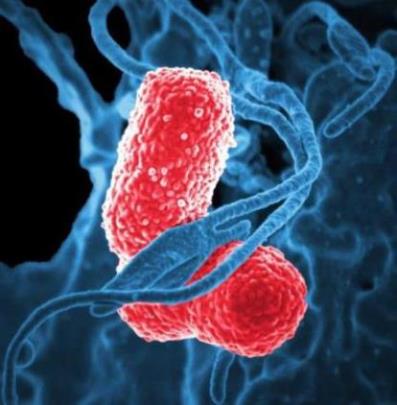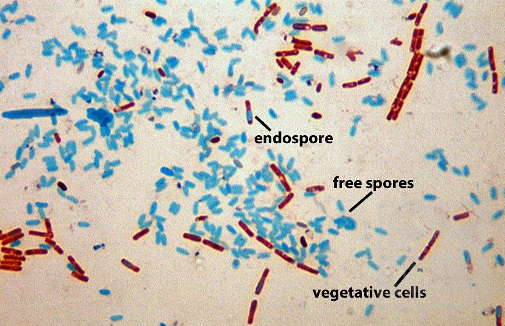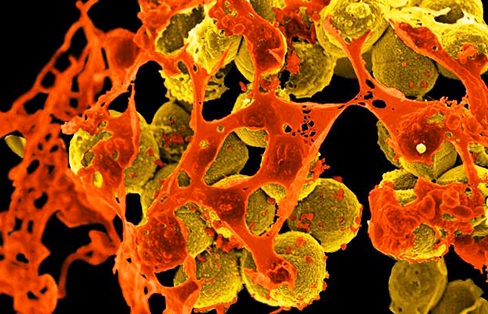Key Concepts
Extremely small, relatively simple microorganisms possessing the prokaryotic type of cell construction. Bacteria are very small prokaryotic microorganisms, usually measuring 0.3 to 2.0 micrometers in diameter (Fig. 1). They are found almost everywhere, being abundant in soil, water, and the alimentary tracts of animals. Each kind of bacterium is fitted physiologically to survive in one of the innumerable habitats created by various combinations of space, food, moisture, light, air, temperature, inhibitory substances, and accompanying organisms. Dried bacteria, but often still living, can be carried into the air. One of the few locations in which bacteria are not usually found is within the cells of other healthy organisms, although even this is subject to exceptions; for example, there are many bacteria that do live intracellularly in a number of eukaryotic organisms. See also: Bacterial growth; Bacterial physiology and metabolism; Bacteriology; Microbiology; Prokaryote

Bacteria have a practical significance for humans. Some bacteria cause disease in humans and domestic animals, thereby affecting health and the economy. Some bacteria are useful in industry, whereas others, particularly in the food, petroleum, and textile industries, can be harmful. In addition, some bacteria improve soil fertility. See also: Clinical microbiology; Disease; Food engineering; Food microbiology; Industrial microbiology; Infectious disease; Medical bacteriology; Petroleum microbiology; Soil microbiology; Textile microbiology
Cultures
Descriptions of bacteria are preferably based on the studies of pure cultures because, in mixed cultures, it is uncertain which bacterium is responsible for observed effects. Pure cultures are sometimes called axenic, a term denoting that all cells had a common origin in being descendants of the same cell, without implying exact similarity in all characteristics. Pure cultures can be obtained by selecting single cells, but indirect methods achieving the same result are more common. If conditions are suitable, each bacterium grows and divides, using food diffused through the gel, and produces a mass of cells called a colony-forming unit (cfu). Colonies always develop until visible to the naked eye, unless toxic products or deficient nutrients limit them to microscopic dimensions. See also: Axenic culture; Culture
Characteristics
The morphology (that is, the shape, size, arrangement, and internal structures) of bacteria can be distinguished microscopically and provides the basis for classifying the bacteria into major groups. Three principal shapes of bacteria exist: spherical (coccus), rod (bacillus; Fig. 2), and twisted rod (spirillum). The coccus may be arranged in chains of cocci (as in Streptococcus) or in tetrads of cocci (as in Sarcina). The rods may be single or in filaments. Stains are used to visualize bacterial structures otherwise not seen, and the stain reaction with Gram's stain provides a characteristic used in classifying bacteria. See also: Stain (microbiology)

Many bacteria are not motile. Of the motile bacteria, however, some move by means of tiny whirling hairlike flagella extending from within the cell. Others are motile without flagella and display a creeping or gliding motion. Spiral forms are usually polarly flagellated, that is, with flagella at the end of the cell. Cocci (spheres) are rarely flagellated. Rod-shaped bacteria may lack flagella or may have polar or peritrichous flagella (that is, flagella around the entire surface of the cell). See also: Cell motility; Cilia and flagella
Many bacteria are enveloped in a capsule, a transparent gelatinous or mucoid layer outside the cell wall. Some form a heat- and drought-resistant spore, called an endospore (Fig. 3), within the cell. Cytoplasmic structures, including reserve fat, protein, and volutin (a basophilic phosphate substance), are occasionally visible within the bacterial cell.

The nucleus of bacteria is prokaryotic, that is, it is not separated from the rest of the cell by a membrane. It contains the pattern material for forming new cells. This material, deoxyribonucleic acid (DNA), which carries the information for synthesis of cell parts, composes a filament with the ends joined to form a circle. The filament consists of two DNA strands joined throughout their length. The joining imparts a helical form to the double strand. The double-stranded DNA consists of linearly arranged hereditary units, analogous and probably homologous with the "genes" of higher forms of life. As in higher life forms, each bacterial cell arises either by division of a preexisting cell with similar characteristics or through combination of elements from two such cells in a sexual process. During cell division and sexual reproduction, the aforementioned hereditary units are duplicated, and a complete set is distributed to each new cell by an orderly (but as yet unelucidated) mechanism. See also: Bacterial genetics; Cell division; Deoxyribonucleic acid (DNA)
The submicroscopic differences that distinguish many bacterial genera and species are due to structures such as enzymes and genes that cannot be seen. The nature of these structures is determined by studying the metabolic activities of the bacteria. Data are accumulated on a number of items: the temperatures and oxygen conditions under which the bacteria grow, their response in fermentation tests, their pathogenicity, and their serological reactions. There are also modern methods for determining directly the similarity in DNA among different bacteria.
Chemical relationships
Bacteria are said to be aerobic if they require oxygen and grow best at a high oxygen tension, usually 20% or more. Microaerophilic bacteria need oxygen, but grow best at, or may even require, reduced oxygen tensions, that is, less than 10%. Anaerobic bacteria do not require oxygen for growth. Obligatorily anaerobic bacteria can grow only in the complete absence of oxygen. In contrast, some bacteria obtain energy from the oxidation of reduced substances with compounds other than oxygen (O2). The sulfate reducers use sulfate, the denitrifiers use nitrate or nitrite, and the methanogenic bacteria use carbon dioxide (CO2) as the oxidizing agents, producing hydrogen sulfide (H2S), nitrogen (N2), and methane (CH4), respectively, as reduction products. See also: Methanogenesis (bacteria); Oxygen
Pathogenicity
Pathogenicity, the ability to cause disease, is another property used in establishing the relationship between various groups of bacteria. Some bacteria produce disease only in certain species; for example, Neisseria gonorrhoeae will cause gonorrhea only in humans. Some bacteria cause only one disease, whereas others may cause several diseases. An example of the former is Corynebacterium diphtheriae, which causes diphtheria; in contrast, Staphylococcus aureus (Fig. 4) belongs to the latter category and may cause boils, osteomyelitis, and pneumonia. See also: Pathogen

Interrelationships
Interrelationships may be close and may involve particular species. Examples include the parasitic association of many bacteria with plant and animal hosts, as well as the mutualistic associations of nitrogen-fixing bacteria with leguminous plants, of cellulolytic bacteria with grazing animals, and of luminous bacteria with certain deep-sea fishes. See also: Mutualism; Nitrogen fixation; Parasitology; Population ecology
Bacteria are also active in other less intimate, but no less important, natural interrelationships. Bacterial decomposition of the dead bodies of animals and especially plants releases the carbon dioxide that is reused by living plants in the process of photosynthesis. Many other chemical activities relate bacteria to other organisms through the world pool of materials essential to life, to which all organisms contribute and from which they draw their food. See also: Photosynthesis
Endospores
Endospores (Fig. 3) are resistant and metabolically dormant bodies produced by the Gram-positive rods of Bacillus (aerobic or facultatively aerobic) and Clostridia (strictly anaerobic), by the coccus Sporosarcina, and by certain other bacteria. Spore-forming bacteria are found mainly in the soil and water and also in the intestines of humans and animals. Some spore-formers are found as pathogens in insects; others are pathogenic to animals and humans. Endospores seem to be able to survive indefinitely. Spores kept for more than 50 years have shown little loss of their capacity to germinate and propagate by cell division.
The endospore appears as a light-refractile body inside another cell (sporangium). Each sporangium produces one endospore with a characteristic size, shape, and position within the cell. The mature spore has a complex structure, which contains a number of layers. The outermost envelope, surrounding the spore, is called the exosporium and is a thin, membranous covering. Beneath the exosporium lies the spore coat, which is composed of several layers, largely of a protein nature; each measures about 2–2.5 nm in thickness. Beneath these is a thin membrane that separates the spore coat from an area of low electron density called the cortex. The cortex is primarily a modified peptidoglycan structure. It occupies approximately half the volume of the spore. A wall and a thin membrane separate the cortex from the cytoplasm of the dormant spore. The unique properties of bacterial spores include their extreme resistance to a number of factors, including heat, radiation from ultraviolet light and x-rays, organic solvents, chemicals, and desiccation.
The capacity of a bacterial cell to form a spore is under genetic control, although the total number of genes specific for sporulation is unknown. The actual phenotypic expression of the spore genome depends on a number of external factors. For each species of spore-forming bacteria, there exist optimum conditions for sporogenesis that differ from the optimal conditions for vegetative growth. These conditions include pH, degree of aeration, temperature, and levels of metals and nutrients.





